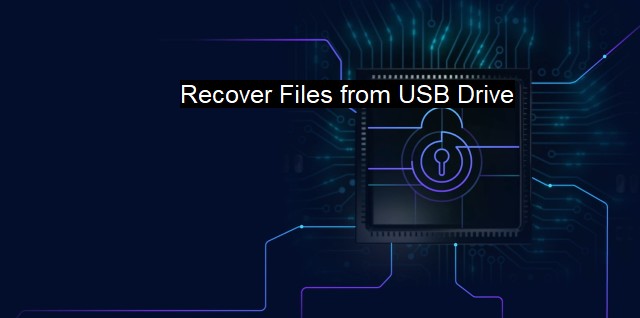What is Recover Files from USB Drive?
Exploring the Nexus of USB Data Recovery, Cybersecurity, and Antivirus: Protecting Your Data from Malicious Threats
Recovering files from a USB drive is critically important amid contemporary worldwide overwhelming dependence on digital technology. Cybersecurity plays a pivotal role and antivirus protection is core for healthy cybersecurity environment. Users utilize USB drives for storage and frequent transport of data. Hence, the potential for data loss or corruption is also high. This can occur due to human errors, virus attacks, mechanical disruptions, or problems with the file systems leading to inaccessible or deleted files. Thus, the process of recovering files from a USB drive demands paramount attention.Recovering files is essentially bringing back data that seems lost, inaccessible, or removed, from any storage medium, including USB drives. This process often involves the use of specific software or services, designed to penetrate the underlying layers of digital storage to retrieve the supposedly lost data.
The relevance of file recovery in USB drives is two-dimensional. First, it concerns data protection - having required measures in place to prevent unauthorized access, alteration, or deletion of stored data. Second, it relates to data recovery - being capable of retrieving lost or corrupted data.
Cybersecurity threats can lead to data loss from a USB drive either by malware or through various forms of hacking. Malevolent software or malware, like viruses, trojans, worms, can be disguised as regular files, swiftly spreading and infecting files. They could rapidly damage, modify, or delete data from a USB drive when connected to an infected device.
One way of countering such cybersecurity threats is to put in place effective antivirus protection. Antivirus software offers extended protection to USB drives by scanning the inserted drive and notifying of any elements of risk before the files are opened. This precludes the chances of a virus spreading to the device and thus represents a first line of defense against potential harm.
In fact, current-age sophisticated antivirus programs can even mend some types of file corruption within the USB drive. They not only identify the harmful threats but also remedy the inflicted damage. Therefore, part of file recovery actions could as well fall within the scope of advanced antivirus software.
Despite arduous cybersecurity measures, data loss or corruption may still happen, frequently infected by potent new viruses or advanced ransomware that may even elude the antivirus software and implant themselves into the system or the peripherals such as USB drives. Consequently, data might get lost, files might be encrypted, or drives may turn inaccessible.
To retrieve the data lost by such potent menaces, or other non-cyber threats like mechanical failures, and accidental deletions, recovery tools come into action. Recovery software essentially dives deep into the storage space on physical media and scans for residual data that has not been overwritten. They can recover different types of files, and some specialized software can specifically focus on certain types like images, videos, or documents.
In recovering potentially lost or corrupted files, users must not write new data on the storage media as it might lead to overwriting, leaving the original data irretrievable. It's also noteworthy that reliable backup routines parallelly facilitate a robust recovery process.
A secured environment ensures not just prevention but also an adequate recovery mechanism if a data disaster strikes. The process of recovering files from a USB drive, thus, plays a paramount role in maintaining data integrity and continuity. Such an approach is needed considering that in the rapidly shifting digital landscape that can be easily overwhelmed by an increasing number are advanced threats combined with human pitfalls. Cybersecurity measures, including antivirus protection and data recovery, are not merely an option anymore - they currently represent integral aspects of maintaining safety, protecting privacy, and ensuring uninterrupted digital experiences.

Recover Files from USB Drive FAQs
What should I do if important files are lost from my USB drive due to a virus attack?
The first thing you should do is to avoid any further use of the USB drive for safety reasons. Then, you can try using reliable data recovery software or services to retrieve your lost files.Is it possible to recover files from a USB drive that has been formatted?
Yes, you can still recover files from a formatted USB drive as long as no new data has been written on it after the formatting process. Use a data recovery tool or service to recover your files.Are there any free data recovery software available that can recover files from a USB drive?
Yes, there are many free data recovery software available that can recover files from a USB drive. However, their success rate may vary depending on the severity of the damage to the drive. Some popular free data recovery tools are Recuva, PhotoRec, and EaseUS Data Recovery Wizard.Can a cybersecurity software or antivirus program recover files from a USB drive?
No, cybersecurity software or antivirus programs are designed to prevent or remove malware from your system. They cannot recover lost or deleted files from your USB drive. You will need to use a dedicated data recovery software or service for this task.| | A | | | B | | | C | | | D | | | E | | | F | | | G | | | H | | | I | | | J | | | K | | | L | | | M | |
| | N | | | O | | | P | | | Q | | | R | | | S | | | T | | | U | | | V | | | W | | | X | | | Y | | | Z | |
| | 1 | | | 2 | | | 3 | | | 4 | | | 7 | | | 8 | | |||||||